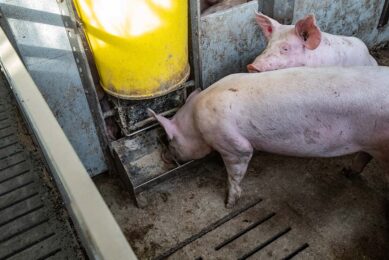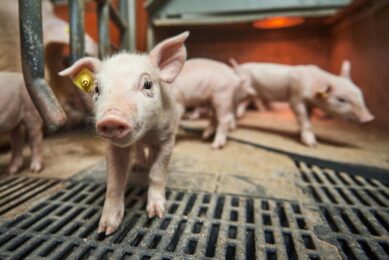A Swine Carbon Footprint model as a decision aid tool

A satiated market has a common feature. No longer is it only relevant how to produce enough pork to feed everybody. Rather the question prevails: ‘How to produce pork better?’ Looking at this question from an environmental angle, the concept of carbon footprint is often introduced. A team of US scientists set out to find out how to further reduce swine production’s carbon footprint.
Do the pork industry’s efforts to improve production and economics affect its greenhouse gas emissions and carbon footprint? A recent study by Boyd and Cady with Camco, a global developer of clean energy projects for the US National Pork Board (NPB), provides insight into the answer of this question. For the fifty years from 1959 to 2009 they report that the number of pigs marketed in the US increased from 87.6 million to 112.6 million. This 29% increase in marketed pigs resulted in an 88% increase in dressed carcass weight. At the same time, the size of the breeding herd decreased by 39%. They also expressed the industry’s increase in production efficiency by stating that in 1959 it took eight pigs (breeding and market) to produce the same amount of pork as five pigs could in 2009.
This same report provides information regarding changes to the greenhouse gas emissions during this same time period. Expressing these emissions on a carbon dioxide equivalent (CO2e) basis, Boyd and Cady report that the 88% increase in annual dressed carcass weight production was associated with a 23% increase in the total carbon footprint. The greater increase in pork production than emissions production is associated with a 35% reduction (from 8.4 kg to 5.5 kg CO2e) in the carbon footprint per kg of pork produced 1959 to 2009.
Carbon footprint
These results indicate that from 1959 to 2009 the 23% increase in greenhouse gas emissions associated with the 88% increase in pork production was limited by 35% decrease in the carbon footprint of each kg of pork produced (Figure 1). Clearly it has been possible to increase production efficiencies while minimising environmental impacts. These results also indicate that the key to managing the industry’s carbon footprint while continuing to supply the demand for pork likely lies in continued efficiency increases.
While the reduction in the carbon footprint per kg of pork produced was largely the result of the industry’s response to production and economic concerns, future reductions will likely benefit from actively including carbon footprint considerations into management decisions. In keeping with this concept the National Pork Board funded a ‘scan level’ life-cycle assessment (LCA) study (Thoma, et al. 2011) of the industry’s emissions and energy use. The connection between energy and emissions is that emissions are often related to energy use. That is, a reduction in energy use is often associated with a reduction in emissions. This study developed a LCA model that considered the production chain from feed crop production to meat processing and retailing.
Using a set of assumptions and inputs representative of a national average, the model indicated about 62% of the emissions were due to live animal production. Associated with live production the two largest contributors to emissions were manure (40% of production, 25% of total emissions) and feed (35% of production and 22% of total emissions), see Figure 2.
Carbon footprint calculator
In an associated effort a carbon footprint calculator was developed and made available on the National Pork Board’s website in 2011. This calculator models the carbon footprint of a swine barn. The intended audiences are pork producers and those providing consulting services. The calculator enables the carbon footprint to be estimated for a given set of conditions that describe a specific barn and management strategies. This capacity provides managers with multiple ‘what if’ scenarios to identify potential opportunities to reduce the barn’s carbon footprint. This information in conjunction with additional production and economic considerations should assist in making informed management decisions that balance production, economic, and emissions concerns.
In 2011, a multistate team of researchers and extension personnel was established to work on a five year USDA-NIFA funded project to improve this carbon footprint model’s ability to serve as a farm-level educational and decision aid tool that incorporates environmental, production, and economic concerns. Broadly speaking the model improvements supported by this project focus on integration of state of the art animal physiology models to account for both growth and manure excretion, integration of detailed models of manure management systems, and extension of the economic evaluation module (Figure 3).The research focus area for the effort to update the model are related to feed and manure management which previous work indicated were the two largest contributors of emissions related to live production. The premise of the feed related research is the concept that the more efficiently an animal is able to convert feed into pork the more pork per unit of feed is produced. There are several potential avenues for emission reductions associated with increases in feed efficiencies:1. If less feed is needed; fewer emissions are produced during the growing, processing and transportation of the needed feed. 2. Increases in feed efficiencies may reduce the emissions related to manure since greater nutrient utilisation and faster growing animals should reduce manure volumes. The reduction in manure volume should result in lower emissions. 3. The impact of animal health on feed efficiency and growth. Conceptually a healthy animal will be more efficient in converting feed to pork with fewer emissions than a sick animal.
Feed related relationships
To investigate these feed related relationships various animal research trials will be done at the University of Arkansas, Virginia Tech, and Purdue. The results of these trials will be used to develop various feed, growth, and emission relationships that will be incorporated into the emissions model.
The manure related research areas can be divided into: the impact on emissions due to changes in animal diet and health status; and the impact on emissions of alternative manure management strategies or systems. In both of these areas changes in practices can result in changes in the volume and chemical characteristics of the manure produced. These manure based changes in turn can result in changes in emissions. Included with the feed, growth, and emission relationships that will be incorporated into the emissions model will be the associated manure changes relationships. Several variations on manure solids separation technologies will also be investigated. Another manure strategy that is to be investigated is the on-farm production of algae as an energy crop. Algae will be grown on large surface water flow raceways at the University of Arkansas swine farm.
The harvested algae and separated manure solids will then be utilised in various thermo-chemical bio-mass to energy research trials. While the adoption rate of manure solids separation in the US has been slow, and the algae to energy implementation on swine farms is still in the concept stage, being able to estimate the impacts of these alternative manure management systems on an operation’s emissions could aid in the making of informed decisions.A critical component of manure management relates emissions associated with the method and timing of manure applications. A significant portion of the effort to update the emissions model is to allow it to couple it with the existing DNDC (DeNitrification-DeCompostion) model. The University of Arkansas and the company DNDC Applications, Research and Training are collaborating on this coupling to enable the resulting emissions estimator to more precisely account for the emissions related to the on-farm management of manure and bio-mass to energy conversion residuals.Building on the National Pork Board’s funding, the team is continuing to develop economic analytical tools to identify costs and benefits of adopting swine management practices that reduce emissions. Associated with this effort will be the use of optimisation models and sensitivity analyses to search for production management practices that minimise emissions and production costs. There will also be evaluations on how volatility in input costs can impact estimates of costs, and benefits of adopting different management practices. The intended end result of these research and model updating efforts is a greenhouse gas, or carbon footprint, calculator that will not only estimate the carbon footprint for a specific set of conditions on a specific farm, but also provide economic information as well.
Extension and education
In addition to the research and model development aspect of the project, there is a significant extension and educational component. The overall objective is to implement education and outreach programmes that assist the understanding of the connections between animal production management systems and greenhouse gas emissions; as well as, the value of the systems approach of lifecycle analysis, in evaluating the impact of specific management decisions on greenhouse emissions.
The primary audience for the project is swine producers as well as the industry and agency professionals that they interact with via the Livestock and Poultry Environmental Learning Center (LPELC). This centre is composed primarily of Land Grant University professionals from across the US who collaborate to provide animal manure management related educational materials through extension (www.extension.org).
References available on request.
Source: Pig Progress magazine 28.7
Join 18,000+ subscribers
Subscribe to our newsletter to stay updated about all the need-to-know content in the pigsector, three times a week. Beheer
Beheer










 WP Admin
WP Admin  Bewerk bericht
Bewerk bericht